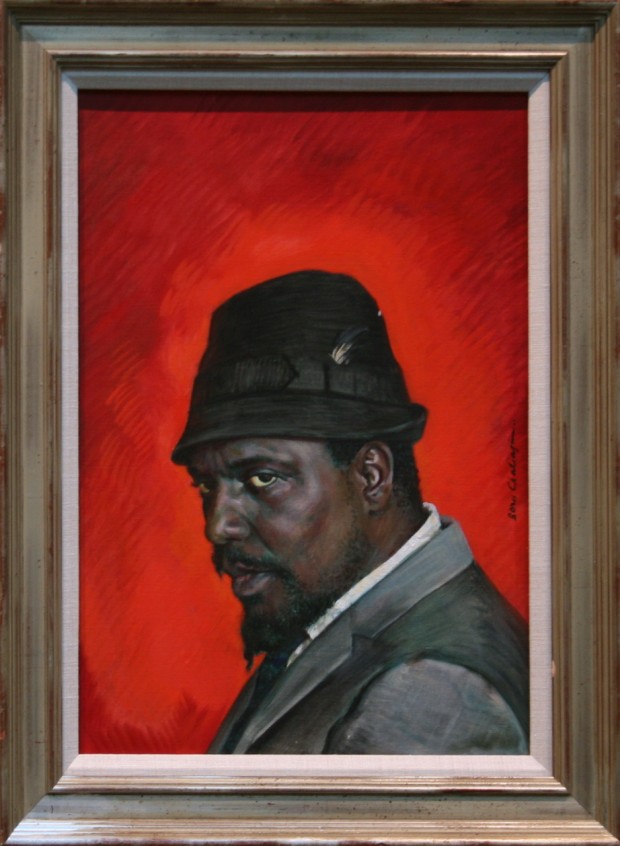An iconographic and text archive related to communication, technology and art.
☛ National Portrait Gallery: Portrait of Thelonious Monk by Boris Chaliapin, oil on canvas, 53.3 x 38.1cm, gift of Time magazine, object number: NPG.78.TC596. The large photo displayed above was taken by Cliffords Photography (CC BY 2.0).
This painting was created specifically for the February 28, 1964 edition of Time magazine (Vol. 83, No. 9: see Time’s official website).

In the issue, Bernhard M. Auer wrote about the process of creating this portrait in his “Letter from the Publisher”:
When this week’s cover artist first met this week’s cover subject, neither quite knew what to make of the other. Painter Boris Chaliapin, son of the late, famed Russian basso, is somewhat more at home in the hot world of opera than in the cool domains of latter-day bop. In answer to requests, Jazz Pianist Thelonious Monk would mutter “All reet,” greatly confusing Chaliapin. When he finally caught on, Chaliapin replied in Russian-accented retaliation: “All root.”
During four sittings Thelonious had a disconcerting habit of dropping off to sleep. Chaliapin would yell at him, “Monk, Monk, wake up!”, then prod him out of his armchair and walk him around the studio. Says he: “Monk’s very strange – in the best sense of the word.” As for Thelonious, it took him a week to learn to pronounce the painter’s name. Having mastered it, he improvised a song that repeated “Chaliapin! Chaliapin!” over and over again, in the manner of “Hallelujah!”
For more about this portrait, see also “Portrait of Thelonious Monk by Boris Chaliapin” (February 24, 2009) over at Face-To-Face, a blog by the National Portrait Gallery. Art Observer has another large reproduction of the same painting: “At National Portrait Gallery, Engaging Images by Renowned Artists”, March 20, 2012.
• • •
The featured article in this issue of Time magazine was titled “The Loneliest Monk” and was written by Barry Farrell (pp. 84-88). It is currently available to read online over at MonkZone.com (as of November 2012). The article is also reproduced in The Thelonious Monk Reader by Rob van der Bliek (Oxford University Press, 2001, pp. 149-160) along with an interesting contextual introduction which is reproduced below:
When Time magazine made Thelonious Monk the subject of its February 28, 1964, cover, it was the fourth time that a jazz musician had been so recognized, the first three being Louis Armstrong (1949), Dave Brubeck (1954), and Duke Ellington (1956). It also instigated a minor spate of public discourse about how the mainstream media had presented Monk and jazz musicians in general, and whether of not Time’s cover article was an honor or a patronizing profile of yet another eccentric entertainer. The sentence “Every day is a brand-new pharmaceutical event for Monk: alcohol, Dexedrine, sleeping potions, whatever is at hand, charge through his bloodstream in baffling combinations” attracted some attention and was construed as damaging to Monk and jazz musicians in general. In fact, other comments in the article about Sonny Rollins, Charles Mingus, John Coltrane, and Miles Davis cast the jazz musician in an unfavorable light. There was anger that mass media had appropriated something that really belonged to a knowing audience. But there was no denying that Monk was one of Columbia’s artists, available through the Columbia Book and Record Club just like any other mainstream artist, and that he was fair game for the publications like Time. Moreover, his peculiar lifestyle and persona made for good copy. (p.149)
From the second paragraph of Barry Farrell’s article “The Loneliest Monk”:
At every turn of his long life in jazz, Monk’s hats have described him almost as well as the name his parents had the crystal vision to invent for him 43 years ago – Thelonious Sphere Monk. It sounds like an alchemist’s formula or a yoga ritual, but during the many years when the owner merely strayed through life (absurd beneath a baseball cap), it was the perfect name for the legends dreamed up to account for his sad silence. “Thelonious Monk? He’s a recluse, man!” In the mid-’40’s, when Monk’s reputation at last took hold in the jazz underground, his name and his mystic utterances (“It’s always night or we wouldn’t need light”) made him seem like the ideal Dharma Bum to an audience of hipsters; anyone who wears a Chinese coolie hat and has a name like that must be cool.
Finally, it’s worth mentioning the documentary Thelonious Monk: Straight, No Chaser (1988) which was directed by Charlotte Zwerin and produced by Clint Eastwood (about 90 mins, learn more about it on IMDb):
- By Philippe Theophanidis
- on
- ― Published in Art
- Tagged: jazz, portrait, Thelonious Monk

